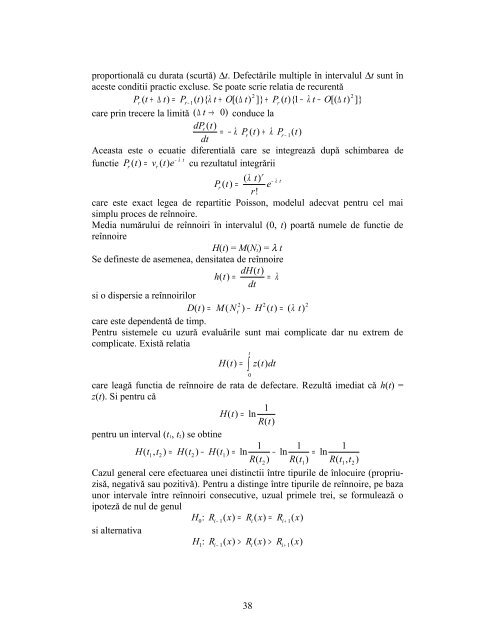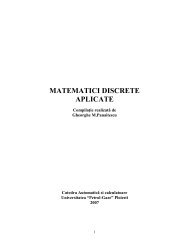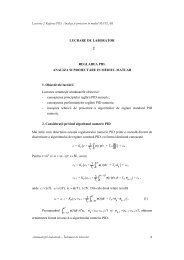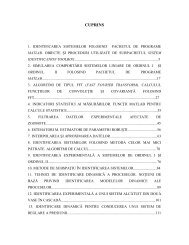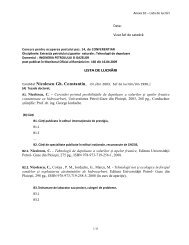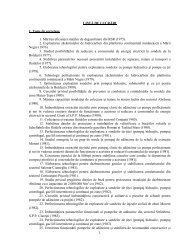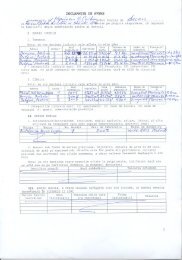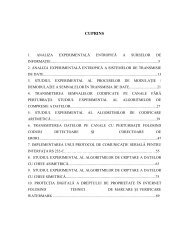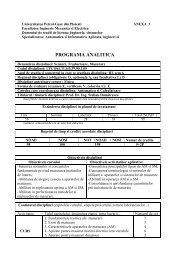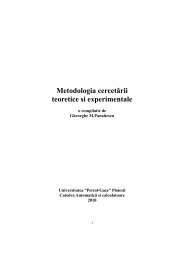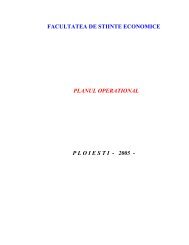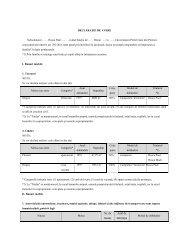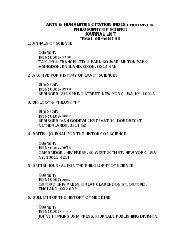Note de curs - Departamentul Automatica, Calculatoare si ...
Note de curs - Departamentul Automatica, Calculatoare si ...
Note de curs - Departamentul Automatica, Calculatoare si ...
You also want an ePaper? Increase the reach of your titles
YUMPU automatically turns print PDFs into web optimized ePapers that Google loves.
proportionalǎ cu durata (scurtǎ) ∆t. Defectǎrile multiple în intervalul ∆t sunt în<br />
aceste conditii practic excluse. Se poate scrie relatia <strong>de</strong> recurentǎ<br />
2<br />
2<br />
Pr<br />
( t + ∆ t)<br />
= Pr<br />
− 1(<br />
t){<br />
λ t + O[(<br />
∆ t)<br />
]} + Pr<br />
( t){1<br />
− λ t − O[(<br />
∆ t)<br />
]}<br />
care prin trecere la limitǎ ( ∆ t → 0 ) conduce la<br />
dPr<br />
( t)<br />
= − λ Pr<br />
( t) + λ Pr<br />
− 1( t)<br />
dt<br />
Aceasta este o ecuatie diferentialǎ care se integreazǎ dupǎ schimbarea <strong>de</strong><br />
− λ t<br />
functie P ( t) = v ( t)<br />
e cu rezultatul integrǎrii<br />
r<br />
r<br />
r<br />
( λ t)<br />
− λ t<br />
Pr<br />
( t)<br />
= e<br />
r!<br />
care este exact legea <strong>de</strong> repartitie Poisson, mo<strong>de</strong>lul a<strong>de</strong>cvat pentru cel mai<br />
<strong>si</strong>mplu proces <strong>de</strong> reînnoire.<br />
Media numǎrului <strong>de</strong> reînnoiri în intervalul (0, t) poartǎ numele <strong>de</strong> functie <strong>de</strong><br />
reînnoire<br />
H(t) = M(N t ) = λ t<br />
Se <strong>de</strong>fineste <strong>de</strong> asemenea, <strong>de</strong>n<strong>si</strong>tatea <strong>de</strong> reînnoire<br />
dH( t)<br />
h( t)<br />
= = λ<br />
dt<br />
<strong>si</strong> o disper<strong>si</strong>e a reînnoirilor<br />
2 2 2<br />
D( t) = M( Nt<br />
) − H ( t) = ( λ t)<br />
care este <strong>de</strong>pen<strong>de</strong>ntǎ <strong>de</strong> timp.<br />
Pentru <strong>si</strong>stemele cu uzurǎ evaluǎrile sunt mai complicate dar nu extrem <strong>de</strong><br />
complicate. Existǎ relatia<br />
H( t) = ∫ z( t)<br />
dt<br />
0<br />
care leagǎ functia <strong>de</strong> reînnoire <strong>de</strong> rata <strong>de</strong> <strong>de</strong>fectare. Rezultǎ imediat cǎ h(t) =<br />
z(t). Si pentru cǎ<br />
1<br />
H( t) = ln<br />
R ( t )<br />
pentru un interval (t 1 , t 2 ) se obtine<br />
1 1 1<br />
H( t1, t2) = H( t2) − H( t1) = ln − ln = ln<br />
R ( t2 ) R ( t1 ) R ( t1 , t2<br />
)<br />
Cazul general cere efectuarea unei distinctii între tipurile <strong>de</strong> înlocuire (propriuzisǎ,<br />
negativǎ sau pozitivǎ). Pentru a distinge între tipurile <strong>de</strong> reînnoire, pe baza<br />
unor intervale între reînnoiri consecutive, uzual primele trei, se formuleazǎ o<br />
ipotezǎ <strong>de</strong> nul <strong>de</strong> genul<br />
H0: Ri − 1( x) = Ri ( x) = Ri<br />
+ 1( x)<br />
<strong>si</strong> alternativa<br />
H : R ( x) > R ( x) > R ( x)<br />
1 i − 1 i i + 1<br />
t<br />
38


